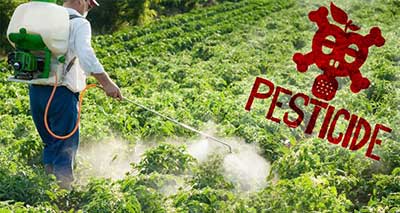Relevance: GS-2: Effect of policies and politics of developed and developing countries on India’s interests.
Key Phrases: Maximum Residue Limits, Pesticide Residue Report, Non-tariff Barriers, Codex Alimentarius Commission, Codex Committee on Pesticide Residues, Integrated Pesticide Management, Certifying consignments, Credibility in Global Markets
Why in News?
- India’s cumin exports have suffered a setback in recent months, with China claiming that pesticide residues have exceeded the maximum residue limits (MRLs) spelled out by it about six months back.
- Chinese authorities have said that consignments must be accompanied by a pesticide residue report.
Key Highlights:
- India has been facing this with respect to its exports of shrimp, rice, chillies, okra, mangoes, and groundnuts in developed markets such as the EU and the US.
- India’s poor farmers are compelled to use excessive pesticides in order to protect their crops.
- But MRL curbs are often arbitrary and deployed as non-tariff barriers by the EU and US (a major horticulture exporter) in particular.
- Hence, MRLs are revised downward to unreasonably low levels, below globally accepted ‘Codex’ standards.
What is the status of Indian Certification Standards?
- India’s fresh fruit imports, amounting to over ₹15,000 crores annually are, not subject to such scrutiny.
- The EU and US have questioned India’s certification processes merely to push their business interests in this field.
- FSSAI standards must be brought to be applicable on such consignments, and be revised if necessary.
- India should challenge inconsistencies in standards across countries.
Do you know about the Codex Alimentarius Commission(CAC)?
- CAC is an international food standards body established jointly by the Food and Agriculture Organization (FAO) and the World Health Organization (WHO) in May 1963 with the objective of protecting consumers’ health and ensuring fair practices in the food trade.
- The Agreement on Application of Sanitary and Phytosanitary Measures (SPS)of the World Trade Organization (WTO) recognizes Codex standards, guidelines, and recommendations as reference standards for international trade and trade dispute settlement.
- Currently, the Codex Alimentarius Commission has 189 Codex Members made up of 188 Member Countries and 1 Member Organization (The European Union). India became a member of Codex Alimentarius in 1964.
- Codex sets Maximum Residue Limits (MRLs) for pesticides in food and feed crops to provide standards for food safety and foster international trade.
- FAO and WHO also develop Pesticide Specifications to set standards for pesticide quality and protect consumers and the environment from the use of substandard products.
The role of Codex in Pesticides:
- The Codex Committee on Pesticide Residues (CCPR) is responsible for establishing Codex Maximum Residue Limits (MRLs) for pesticide residues in specific food items or in groups of food or feed that move in international trade.
- Before a Codex MRL can be established human health risk assessments must be conducted to ensure the food supply is safe.
- It is the responsibility of the Joint FAO/WHO Meeting on Pesticide Residues (JMPR) to review the appropriate toxicology and data obtained mainly from supervised trials, that reflect approved pesticide use in accordance with "good agricultural practice."
- JMPR conducts dietary risk assessments and recommends specific MRLs to the Codex Committee.
Way Forward for India:
- Reviewing Dangerous Pesticides and Weedicides:
- In 2018, the Centre banned 18 of the 100 or so globally banned pesticides allegedly in use in India.
- It should objectively review the use of these controversial and dangerous pesticides and weedicides while recognising that yields and post-harvest losses too need to be protected.
- Law on Pesticides Management:
- The proposed new law on pesticide management, under which a central authority will authorise the marketing of pesticides and ideally review clearances periodically, must be implemented sincerely.
- It is also ironic that some of the biggest pesticide producers are EU-based, and the bans announced by the EU do not seem to impact sales in developing countries.
- Institutional capacity Mechanism:
- The lack of institutional capacity to implement integrated pesticide management (IPM) needs to be addressed.
- In the case of spices and commodities, the respective boards should take up the task of certifying consignments.
- FSSAI’s regulation capacity must be enhanced as India’s spices exports amount to over ₹25,000 crores, while fresh vegetables and processed fruits and juices amount to another ₹10,000 crores.
- One district One Product Program:
- The creation of ‘one district one product’ to promote unique farm produce such as Jalgaon bananas and Ratnagiri Alphonso mangoes must be accompanied by extension services on MRL norms as well as testing facilities.
- Promotion of Cooperatives:
- Ensuring traceability of inputs is important for global markets.
- This is easier done when the produce is routed through cooperatives, FPOs, or contract farming systems.
Conclusion:
- India has done well to win back credibility in global markets with respect to grapes and shrimp exports.
- In both cases, the right processes were put in place. Gherkins export has not run into such problems.
- India’s export potential in horticulture is considerable, as it is the world’s second largest producer of fruit and vegetables but has no more than a 2 percent share in global horticulture exports.
- In dealing with global norms and trade pressures, it should not overlook the interests of its producers and consumers.
Source: The Hindu BL
Mains Question:
Q. Indian Exports have suffered a setback in the markets of developed nations on accounts of the maximum residue limits set by them. In light of this, suggest the way forward so that the Indian exports win back their credibility in the global markets.







